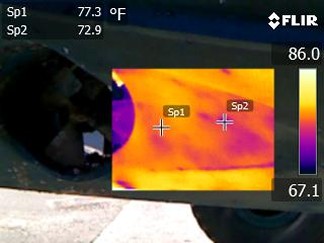mutski":1r25b4jc said:
How does the FLIR identify moisture? How does one use it?
The FLIR is mostly infrared spectrum, and records in color, the outline of the object, and various temperatures defined by change of color. Red- to White is very hot, and green to blue is cool. There are various color palettes, and the surveyor can choose. Ironwood, is a commonly used palette. There are temperatures assigned to the limited of that specific picture:
This photo is lifted off a
surveryor's web site: Suenos Azules Marine Surveying and Consulting , and shows cool blistering just aft of the bow thruster. The explanation and more photos are well shown on this web site.
The boat has to be heated enough to show the difference between dry fiberglass/core vs fiberglass laminate or core with water intrusion (cooler).
I have a hand held FLIR scope, and although it is not calibrated, and as sophisticated as a dedicated FLIR camera or adaptor to use with an IOS phone/android phone, it will detect temperature differences enough to show obvious wetness.
We have also done some studies with ultrasonics to identify delamination and wet core laminate. (This was done with non destructive testing gear, but on samples we. had taken from 25 hurricane damaged boats which were going to be scrapped.) We were also able to determine the moisture content of the samples, by weight before and after dehydration in an oven. This testing gear is not available to the public. Surveyors rejected it because it costs a few thousand dollars and requires training to use.
FLIR is also very useful in looking at electric terminals, and seeing if there is excess heating, suggesting increased resistance at that specific point.
I have never "looked" at a C Dory with entirely saturated core. One would need dry core to compare it with on the same boat.
Unfortunately not all surveyors use FLIR. It is a great tool, when used properly. (training, and right equipment are key.)

